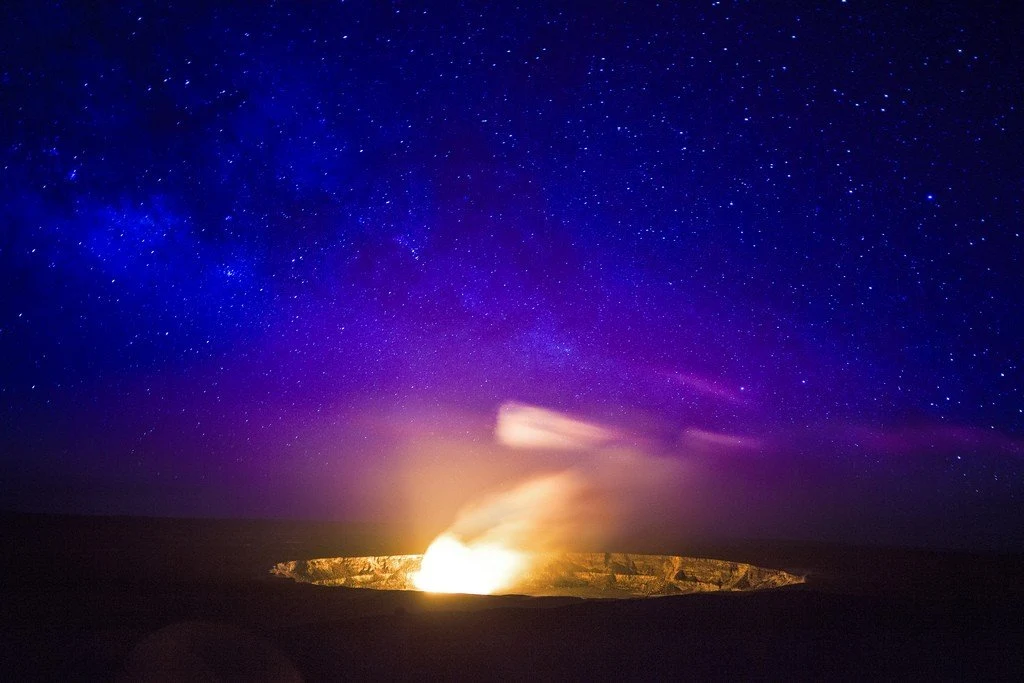Hawaii is usually associated with luxurious beaches, surfing, ocean surf, an abundance of flowers and dancing. however, the fiftieth state has added another unique national reserve to the common piggy bank.
 |
| Hawai i Volcanoes National Park |
Hawaiʻi Volcanoes National Park on the island of Hawaii. Here you can see the result of thousands of years of volcanic activity, migration and evolution processes that have formed the land in the middle of the ocean with a unique ecosystem. The park is home to the active volcanoes Kilauea and Mauna Loa. A slow but continuous eruption has been occurring on Kilauea since 1983, making it one of the most active volcanoes on Earth.
General Information
The ground and rocks below this South Sea island are a very precarious foundation. The Hawaiian archipelago is the result of volcanic activity: its 137 islands are the summits of underwater volcanoes. This chain lies just along the edge of the great Pacific tectonic plate, which moves 10 cm to the northwest every year. Volcanoes of Hawaiʻi Volcanoes National Park are located on the main island, which is locally called the "Big Island". These are the most active volcanoes on the planet.
 |
| Hawai i Volcanoes National Park |
The reserve was founded on August 1, 1916, and then it was called the Hawaiʻi Volcanoes National Park. Protected status 1300 sq. km of its area was confirmed in 1961 under the modern name. Hawaiʻi Volcanoes National Park includes a unique ecological system, from ocean beaches with black sand to fire-breathing mountains.
Rising 4169 m above sea level, Mauna Loa is the largest volcano on Earth. Its foot goes into one of the deepest depressions in the Pacific Ocean, adding another 5000 m to the first figure. This means that the total height of Mauna Loa is more than 9100 m, much higher than the height of Mount Everest (8848 m). Mauna Loa's "little brother" is Kilauea. Although it is far from the size of Mauna Loa, Kilauea is the most active volcano on the planet. Both mountains are classified as shield volcanoes, like most volcanoes in Hawaii.
 |
| Hawai i Volcanoes National Park |
Aboriginal people have a legend explaining why Kilauea is so restless and sometimes even cruel. Locals believe that the Kilauea crater, Halemaumau, is the home of the fire goddess Pele, a very hot-tempered person. The girl easily loses control over herself and begins to literally spit fire and red-hot lava anywhere. Then Pele calms down and plunges into a blessed sleep. To appease such an ardent goddess, or at least temper her furious anger, the natives bring gifts for Pele and leave them at the edge of the crater. This custom is sacredly observed in our days.
Geologists, as always, explain Kilauea's tough temper in a more pragmatic way. The most popular theory is the so-called hotspot idea. A hot spot is any area that exhibits volcanic activity for a sufficiently long period of time without lava eruptions. This theory assumes the presence of huge cavities under the surface of the Earth, from which magma rises relatively slowly compared to real eruptions. The Pacific tectonic plate floats just above such a giant magma lake. Internal pressure, provoking continental drift, pushes magma to the surface, a new island appears with inevitable volcanic activity. So, there is nothing surprising in the fact that Kilauae now and then erupt, throwing thin fountains of lava into the sky day and night.
 |
| Hawai i Volcanoes National Park |
Facts
- Base: Hawaiʻi Volcanoes National Park was founded on the Hawaii archipelago on August 1, 1916. Today its area is 1309 sq. km.
- Altitude: Hawaiʻi Volcanoes National Park rises 4169 m above sea level at its highest point, Mauna Loa. If we count from its foot on the ocean floor, then the height of this volcano will be 9100 m.
- Eruptions: Since 1983, Kilauea has continued to erupt. It has long been considered the most active volcano on the planet.
- UNESCO World Heritage Site: Hawaiʻi Volcanoes National Park was included in the UNESCO World Heritage List in 1987.
